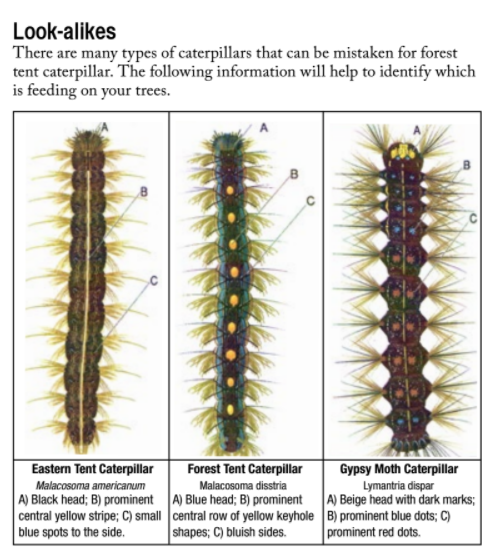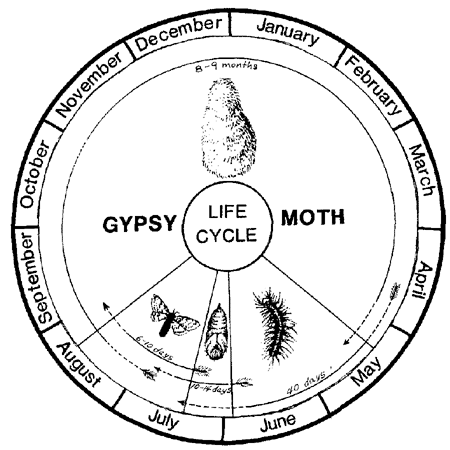Gypsy Moths and other Forest Pests
There are several forest caterpillars present in our county. Most of these caterpillars are native and their numbers are controlled through other natural predators.
Gypsy Moth Life Cycle
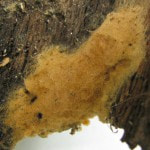 A Gypsy Moth Egg Mass
A Gypsy Moth Egg Mass
SEPTEMBER - MAY
A single egg mass is intertwined in a matting of hair from the body of the female. The hair is a tan-buff color, very water repellent and a good insulator. These egg masses range in size from one to three inches long and are sometimes tear dropped in shape. An egg mass can contain from 50 to 1,500 eggs. Hatching occurs around the first of May and coincides with the time tree buds start to open. This stage lasts for 7-10 days.
A single egg mass is intertwined in a matting of hair from the body of the female. The hair is a tan-buff color, very water repellent and a good insulator. These egg masses range in size from one to three inches long and are sometimes tear dropped in shape. An egg mass can contain from 50 to 1,500 eggs. Hatching occurs around the first of May and coincides with the time tree buds start to open. This stage lasts for 7-10 days.
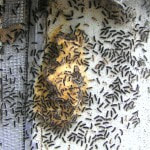 Hatching Gypsy Moth Larvae
Hatching Gypsy Moth Larvae
MAY
Hatched larvae are 3mm to 5 mm long and usually black in color. They linger around the egg mass for several days if the weather is cool or rainy, then climb trees or other objects, trailing silken threads as they move. When the larvae reach the top, they do not feed but drop on silken threads and are dispersed by the wind. Feeding at night for 4 to 6 weeks, large larvae generally rest during the heat of the day unless populations are very large, then they wander constantly. They continue to feed, shed the outer skin and feed until they are about 2 inches long.
Hatched larvae are 3mm to 5 mm long and usually black in color. They linger around the egg mass for several days if the weather is cool or rainy, then climb trees or other objects, trailing silken threads as they move. When the larvae reach the top, they do not feed but drop on silken threads and are dispersed by the wind. Feeding at night for 4 to 6 weeks, large larvae generally rest during the heat of the day unless populations are very large, then they wander constantly. They continue to feed, shed the outer skin and feed until they are about 2 inches long.
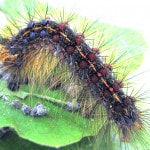 Feeding Caterpiller
Feeding Caterpiller
MAY - JULY
Adult feeding caterpillar identified by the beige head with dark marks, five pairs of blue dots followed by six pairs of red dots.
Adult feeding caterpillar identified by the beige head with dark marks, five pairs of blue dots followed by six pairs of red dots.
 Pupa Stage
Pupa Stage
MID JULY - EARLY AUGUST
During the stationary stage the larvae are changing into moths. This generally occurs from the middle of July until early August. After about 10 days in the dark colored pupa cases, the adult moths emerge, leaving the pupa cases behind.
During the stationary stage the larvae are changing into moths. This generally occurs from the middle of July until early August. After about 10 days in the dark colored pupa cases, the adult moths emerge, leaving the pupa cases behind.
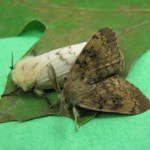
AUGUST - EARLY SEPTEMBER
The female moth is creamy white and does not fly but emits a chemical called a pheromone to attract a male moth. The male is brownish and flies in a zigzag pattern looking for a female. A single male can mate with many females. Both sexes have chevron markings (v or notch-shaped markings) on each forewing.
The female moth is creamy white and does not fly but emits a chemical called a pheromone to attract a male moth. The male is brownish and flies in a zigzag pattern looking for a female. A single male can mate with many females. Both sexes have chevron markings (v or notch-shaped markings) on each forewing.

